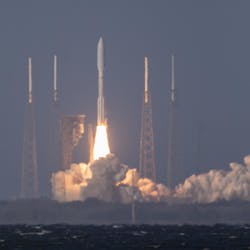CAPE CANAVERAL, Fla., - NASA successfully launched the third in a series of next-generation weather satellites for the National Oceanic and Atmospheric Administration (NOAA) at 4:38 p.m. EST Tuesday. The newest Geostationary Operational Environmental Satellite, GOES-T, launched on a United Launch Alliance Atlas V rocket from Cape Canaveral Space Force Station.
GOES-T mission managers confirmed at 8:28 p.m. the spacecraft’s solar arrays successfully deployed and the spacecraft was operating on its own power.
“We at NASA are proud to support our joint agency partner, NOAA, and their mission to provide critical data and imagery to forecasters and researchers tracking hazardous weather,” said NASA Deputy Administrator Pam Melroy. “While the GOES-R series satellites’ main job is to help with weather prediction, these satellites produce observations that also help with NASA science. Our agencies’ collaboration brings great benefits toward understanding our planet.”
The satellite will provide continuous coverage of weather and hazardous environmental conditions in the Western Hemisphere. The GOES program also predicts space weather near Earth that can interfere with satellite electronics, GPS, and radio communications.
Once GOES-T is positioned in a geostationary orbit 22,300 miles above Earth, it will be renamed GOES-18. Following a successful orbital checkout of its instruments and systems, GOES-18 will go into service over the U.S. West Coast and Pacific Ocean. This position puts it in a key spot where it can observe weather sweeping in from the west to the east over the U.S. – giving forecasters an upstream view of what is coming.
NASA’s Goddard Space Flight Center in Greenbelt, Maryland, oversees the acquisition of the GOES-R spacecraft and instruments and built the Magnetometer instrument for GOES-T, as well as for the future GOES-U satellite. NASA’s Launch Services Program, based at the agency’s Kennedy Space Center in Florida, provided launch management for the mission. NOAA oversees the GOES-R Series Program through an integrated NOAA-NASA office, managing the ground system, operating the satellites, and distributing their data to users worldwide. Lockheed Martin designs, builds, and tests the GOES-R series satellites. L3Harris Technologies provides the main instrument payload, the Advanced Baseline Imager, along with the ground system, which includes the antenna system for data reception.

